An Assessment of Hazards and Associated Risks in Greek Swimming Pools
Abstract
1. Introduction
2. Materials and Methods
3. Results
3.1. Physicochemical Parameters
3.1.1. Residual Chlorine
3.1.2. pH Parameter Measurements
3.1.3. Total Alkalinity and Cyanuric Acid
3.1.4. Compliance After Recommendations
3.2. Microbiological Parameters
3.3. On-Site Inspections
3.4. Risk Assessment Matrix for Swimming Pool Safety
4. Discussion
4.1. Microbiological Hazards and Chemical Imbalances
4.2. Microbial Contamination and Public Health Risks
4.3. Chemical Risks and Disinfection By-Products (DBPs).
4.4. Operational Challenges and Compliance
4.5. Structured Risk Management Framework
4.6. Implications for Public Health and Tourism
5. Conclusions
Author Contributions
Funding
Data Availability Statement
Conflicts of Interest
References
- Final Report Summary—POOLSAFE (A Novel Swimming Pool Water Treatment for the Detection and Elimination of Excess Cyanuric Acid). 2024. Available online: https://cordis.europa.eu/project/id/604884/reporting (accessed on 10 January 2025).
- Swimming Pool Construction Market Size, Share & Trends Analysis Report By Material (Concrete, Fiberglass, Steel Frame, Vinyl Liner), By Construction Type (Above-Ground, In-Ground), By End User (Residential, Commercial) and By Region(North America, Europe, APAC, Middle East and Africa, LATAM) Forecasts, 2024-2032. 2024. Available online: https://straitsresearch.com/report/swimming-pool-construction-market (accessed on 10 January 2025).
- Mavridou, A.; Pappa, O.; Papatzitze, O.; Mplougoura, A.; Drossos, P. An overview of pool and spa regulations in Mediterranean countries with a focus on the tourist industry. J. Water Health 2014, 12, 359–371. [Google Scholar] [CrossRef] [PubMed]
- Nikolaidou, S.; Anestis, A.; Bartzoki, S.-F.; Lampropoulou, E.; Dardavesis, T.; Haidich, A.-B.; Tirodimos, I.; Tsimtsiou, Z. Microbiological water quality assessment of swimming pools and jacuzzis in Northern Greece: A retrospective study. Int. J. Environ. Health Res. 2024, 16, 1–10. [Google Scholar] [CrossRef] [PubMed]
- Mavridou, A.; Pappa, O.; Papatzitze, O.; Dioli, C.; Kefala, A.M.; Drossos, P.; Beloukas, A. Exotic Tourist Destinations and Transmission of Infections by Swimming Pools and Hot Springs—A Literature Review. Int. J. Environ. Res. Public Health 2018, 15, 2730. [Google Scholar] [CrossRef] [PubMed]
- Sfyri, E.; Kefala, V.; Papageorgiou, E.; Mavridou, A.; Beloukas, A.; Rallis, E. Viral Cutaneous Infections in Swimmers: A Preliminary Study. Water 2021, 13, 3401. [Google Scholar] [CrossRef]
- Carter, R.A.A.; Joll, C.A. Occurrence and formation of disinfection by-products in the swimming pool environment: A critical review. J. Environ. Sci. 2017, 58, 19–50. [Google Scholar] [CrossRef] [PubMed]
- Johannesson, S.; Eriksson, K.; Wastensson, G.; Westerlund, J.; Graff, P. Airborne trichloramine in indoor swimming pools in Sweden. J. Occup. Environ. Hyg. 2024, 21, 805–816. [Google Scholar] [CrossRef] [PubMed]
- World Health Organization. Guidelines for Safe Recreational-Water Environments Final Draft for Consultation Vol. 2: Swimming Pools, Spas and Similar Recreational-Water Environments. 2006. Available online: https://apps.who.int/iris/handle/10665/43336 (accessed on 10 January 2025).
- Brecher, R.W. Risk Assessment. Toxicol. Pathol. 1997, 25, 23–26. [Google Scholar] [CrossRef] [PubMed]
- ISO 31000: 2018; Risk Management-Guidelines. ISO: London, UK, 2018.
- Hesami Arani, M.; Jaafarzadeh, N.; Dehabadi, P.; Mostafaii, G.; Tazik, M.; Karimi, Z.; Etesam, A.; Mohammadzadeh, M. Health and safety hazards identification and risk assessment in the swimming pools using combined HAZID and ALARP. Environ. Health Eng. Manag. 2020, 7, 151–160. [Google Scholar] [CrossRef]
- Berg, A.; Fang, T.-A.; Tang, H. Variability of residual chlorine in swimming pool water and determination of chlorine consumption for maintaining hygienic safety of bathers with a simple mass balance model. J. Water Health 2018, 17, 227–236. [Google Scholar] [CrossRef]
- Norlin, J.I. Public health investigation of swimming pool chlorine gas disinfection systems. Environ. Health Rev. 2019, 62, 53–58. [Google Scholar] [CrossRef]
- Sanitary Order Γ1/443/1973—Government Gazette B-87/24-1-1973, About Swimming Pools Following Instructions for Their Construction and Operation. 1973. Available online: https://www.elinyae.gr/ethniki-nomothesia/ya-g14431973-fek-87b-2411973 (accessed on 10 January 2025).
- EN 15288-1; Swimming Pools—Part 1: Safety Requirements for Design. CEN—European Committee for Standardization: Brussels, Belgium, 2018.
- EN 15288-2; Swimming Pools—Part 2: Safety Requirements for Operation. CEN—European Committee for Standardization: Brussels, Belgium, 2018.
- Bartram, J.; Fewtrell, L.; Stenström, T. Harmonised Assessment of Risk and Risk Management for Water-related Infectious Disease: An overview. In Water Quality: Guidelines, Standards and Health; WHO: Geneva, Switzerland, 2001; pp. 1–16. [Google Scholar]
- ISO 19458:2006; Water Quality—Sampling for Microbiological Analysis. ISO: London, UK, 2006.
- ISO 9308-1:2014; Water Quality—Enumeration of Escherichia Coli and Coliform Bacteria Part 1: Membrane Filtration Method for Waters with Low Bacterial Background Flora. ISO: London, UK, 2014.
- ISO 16266:2006; Water Quality—Detection and Enumeration of Pseudomonas Aeruginosa—Method by Membrane Filtration. ISO: London, UK, 2006.
- ISO/DIS 7899-3; Water Quality—Enumeration of Intestinal Enterococci—Part 3: Most Probable Number Method. ISO: London, UK, 2023.
- ISO 6222:1999; Water Quality—Enumeration of Culturable Micro-Organisms—Colony Count by Inoculation in a Nutrient Agar Culture Medium. ISO: London, UK, 1999.
- Guidelines on Recreational Water Quality: Volume 1 Coastal and Fresh Waters. 2021. Available online: https://iris.who.int/bitstream/handle/10665/342625/9789240031302-eng.pdf?sequence=1 (accessed on 10 January 2025).
- Canadian Recreational Water Quality Guidelines—Indicators of Fecal Contamination: E. coli and Enterococci in Recreational Waters. 2023. Available online: https://www.canada.ca/en/health-canada/services/publications/healthy-living/recreational-water-quality-guidelines-indicators-fecal-contamination/e-coli-enterococci.html (accessed on 10 January 2025).
- Guidance on the Use of Enterococci as an Indicator in Canadian Drinking Water Supplies. 2020. Available online: https://www.canada.ca/en/health-canada/services/publications/healthy-living/guidance-use-enterococci-indicator-canadian-drinking-water-supplies.html (accessed on 10 January 2025).
- Pool Water Treatment Advisory Group (PWTAG) Code of Practice: The Management and Treatment of Swimming Pool Water. 2024. Available online: http://www.pwtag.org/code-of-practice/ (accessed on 10 January 2025).
- MedCalc. MedCalc's Relative Risk Calculator; MedCalc Software Ltd.: Ostend, Belgium, 2023. [Google Scholar]
- Barwick, R.S.; Levy, D.A.; Craun, G.F.; Beach, M.J.; Calderon, R.L. Surveillance for waterborne-disease outbreaks--United States, 1997–1998. MMWR. CDC Surveill. Summ. 2000, 49, 1–21. [Google Scholar] [PubMed]
- Craun, G.F.; Calderon, R.L.; Craun, M.F. Outbreaks associated with recreational water in the United States. Int. J. Environ. Health Res. 2005, 15, 243–262. [Google Scholar] [CrossRef] [PubMed]
- Craun, G.F.; Calderon, R.L.; Wade, T.J. Assessing waterborne risks: An introduction. J Water Health 2006, 4 (Suppl. 2), 3–18. [Google Scholar] [CrossRef] [PubMed]
- Mellou, K.; Mplougoura, A.; Mandilara, G.; Papadakis, A.; Chochlakis, D.; Psaroulaki, A.; Mavridou, A. Swimming Pool Regulations in the COVID-19 Era: Assessing Acceptability and Compliance in Greek Hotels in Two Consecutive Summer Touristic Periods. Water 2022, 14, 796. [Google Scholar] [CrossRef]
- Guida, M.; Di Onofrio, V.; Gallè, F.; Gesuele, R.; Valeriani, F.; Liguori, R.; Romano Spica, V.; Liguori, G. Pseudomonas aeruginosa in Swimming Pool Water: Evidences and Perspectives for a New Control Strategy. Int. J. Environ. Res. Public Health 2016, 13, 90919. [Google Scholar] [CrossRef] [PubMed]
- Rice, S.A.; van den Akker, B.; Pomati, F.; Roser, D. A risk assessment of Pseudomonas aeruginosa in swimming pools: A review. J. Water Health 2012, 10, 181–196. [Google Scholar] [CrossRef] [PubMed]
- Williams, C.J.; Conrad, D.; Kothawala, D.N.; Baulch, H.M. Selective removal of dissolved organic matter affects the production and speciation of disinfection byproducts. Sci. Total Environ. 2019, 652, 75–84. [Google Scholar] [CrossRef] [PubMed]
- Diana, M.; Felipe-Sotelo, M.; Bond, T. Disinfection byproducts potentially responsible for the association between chlorinated drinking water and bladder cancer: A review. Water Res. 2019, 162, 492–504. [Google Scholar] [CrossRef] [PubMed]
- Pasquarella, C.; Veronesi, L.; Napoli, C.; Castaldi, S.; Pasquarella, M.; Saccani, E.; Colucci, M.; Auxilia, F.; Gallè, F.; Di Onofrio, V.; et al. What about behaviours in swimming pools? Results of an Italian multicentre study. Microchem. J. 2014, 112, 190–195. [Google Scholar] [CrossRef]
- Kyriakis, K.P.; Palamaras, I.; Terzoudi, S.; Emmanuelides, S.; Michailides, C. Case detection rates of molluscum contagiosum in childhood. Pediatr. Dermatol. 2007, 24, 198–199. [Google Scholar] [CrossRef] [PubMed]

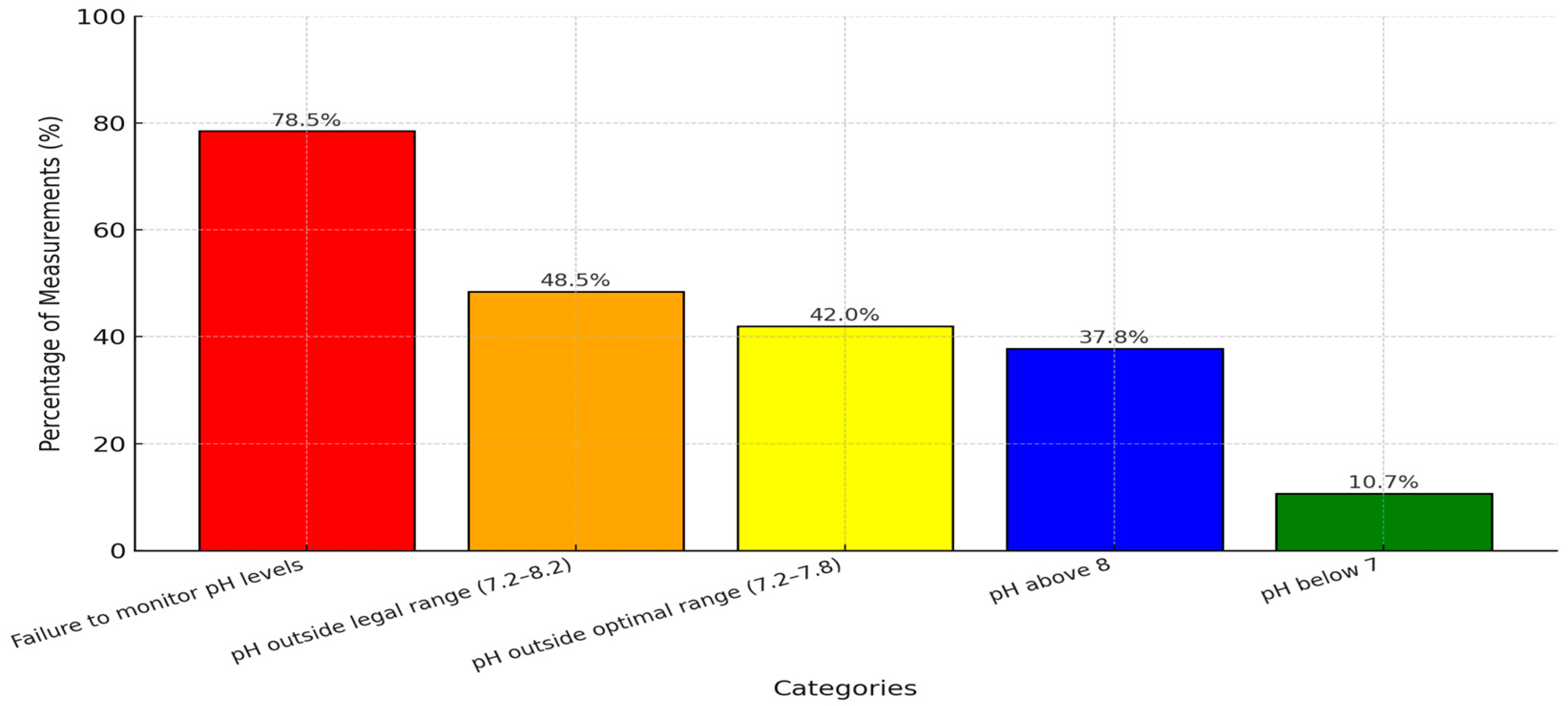
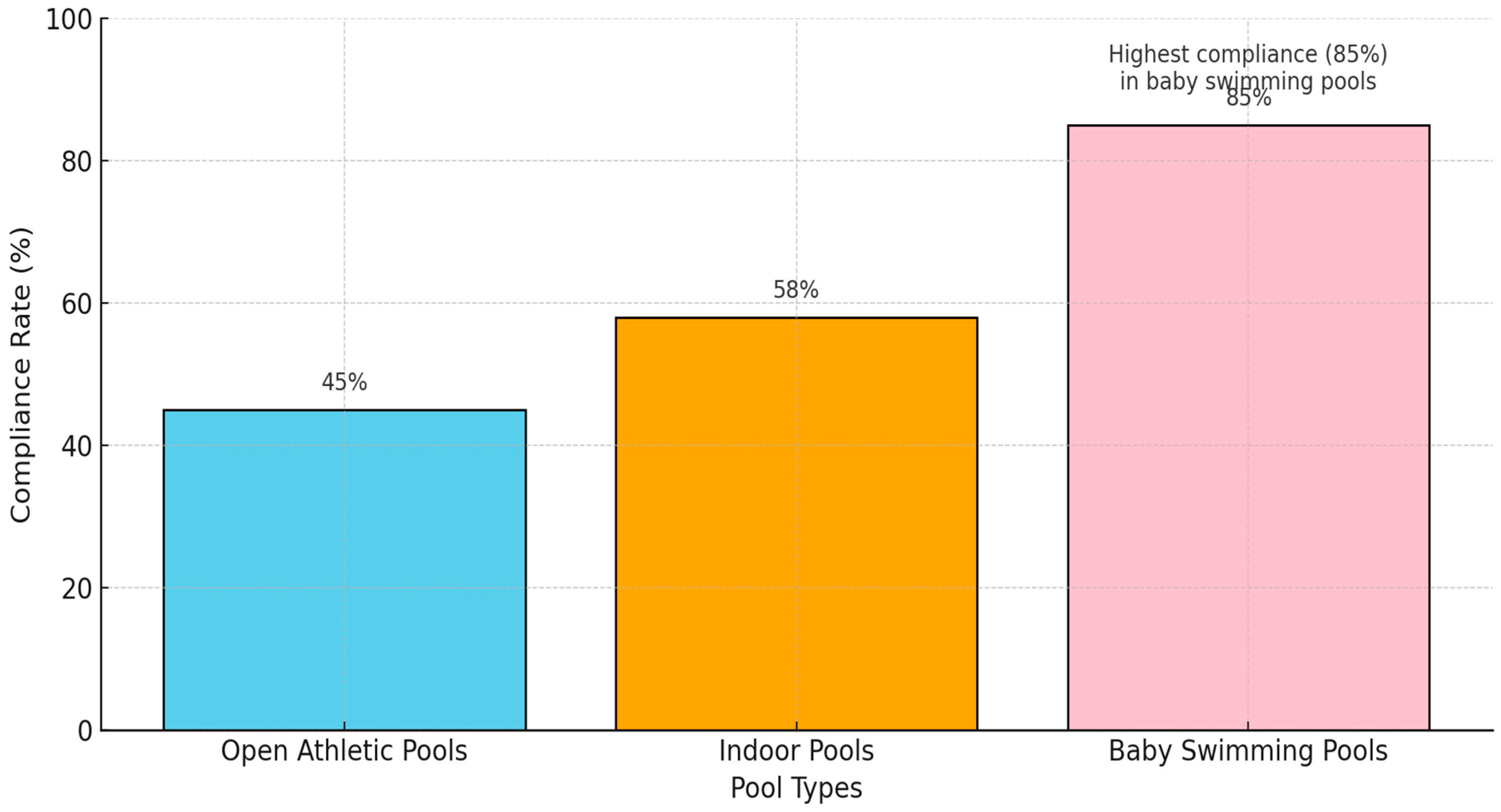
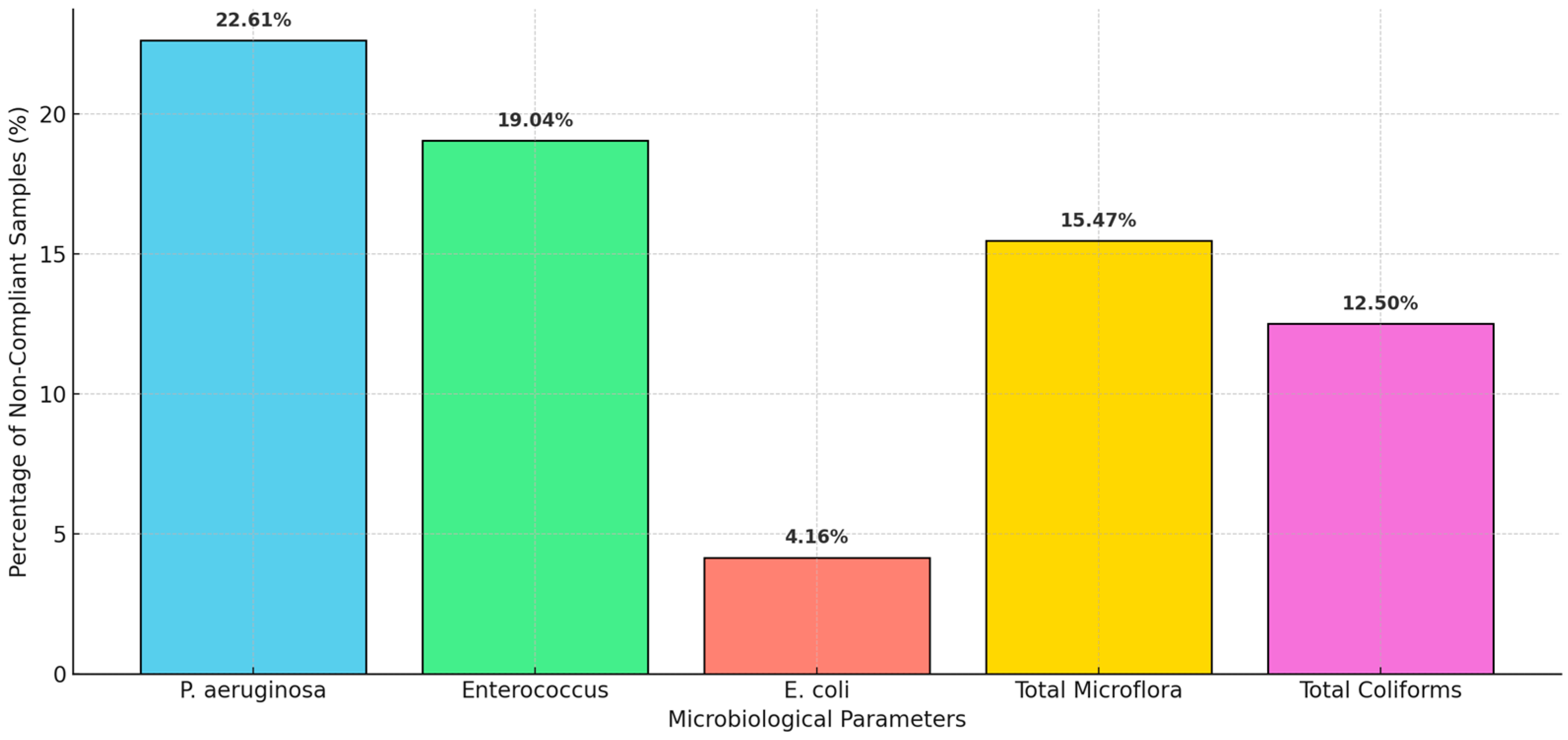
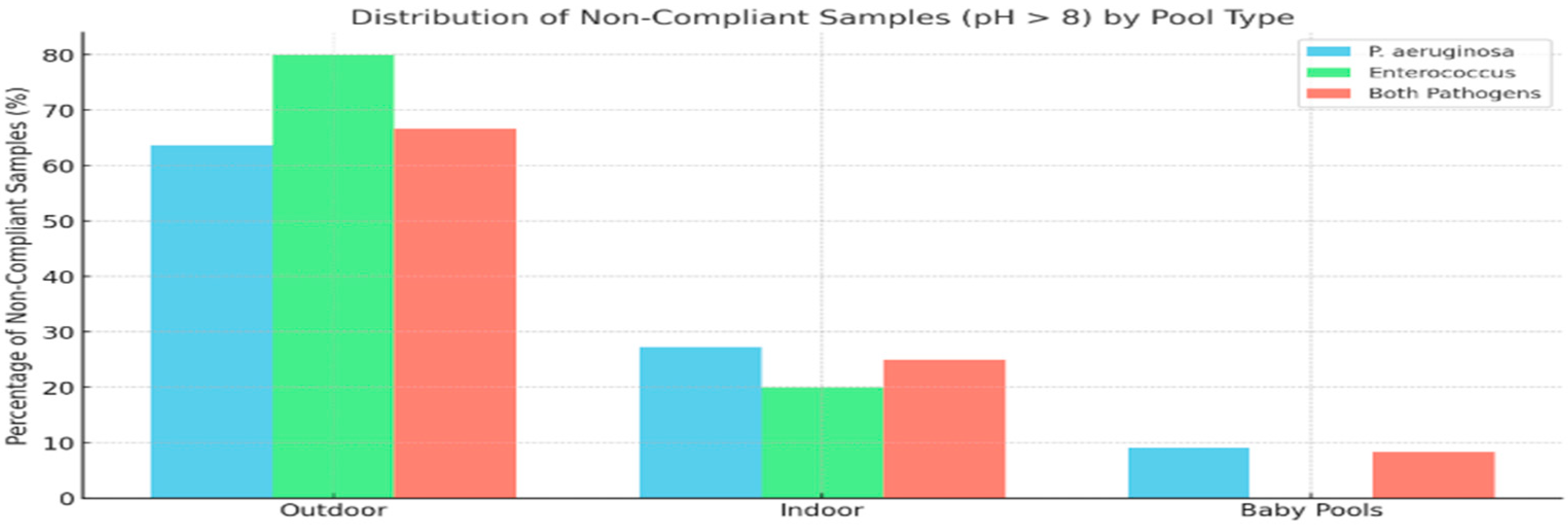
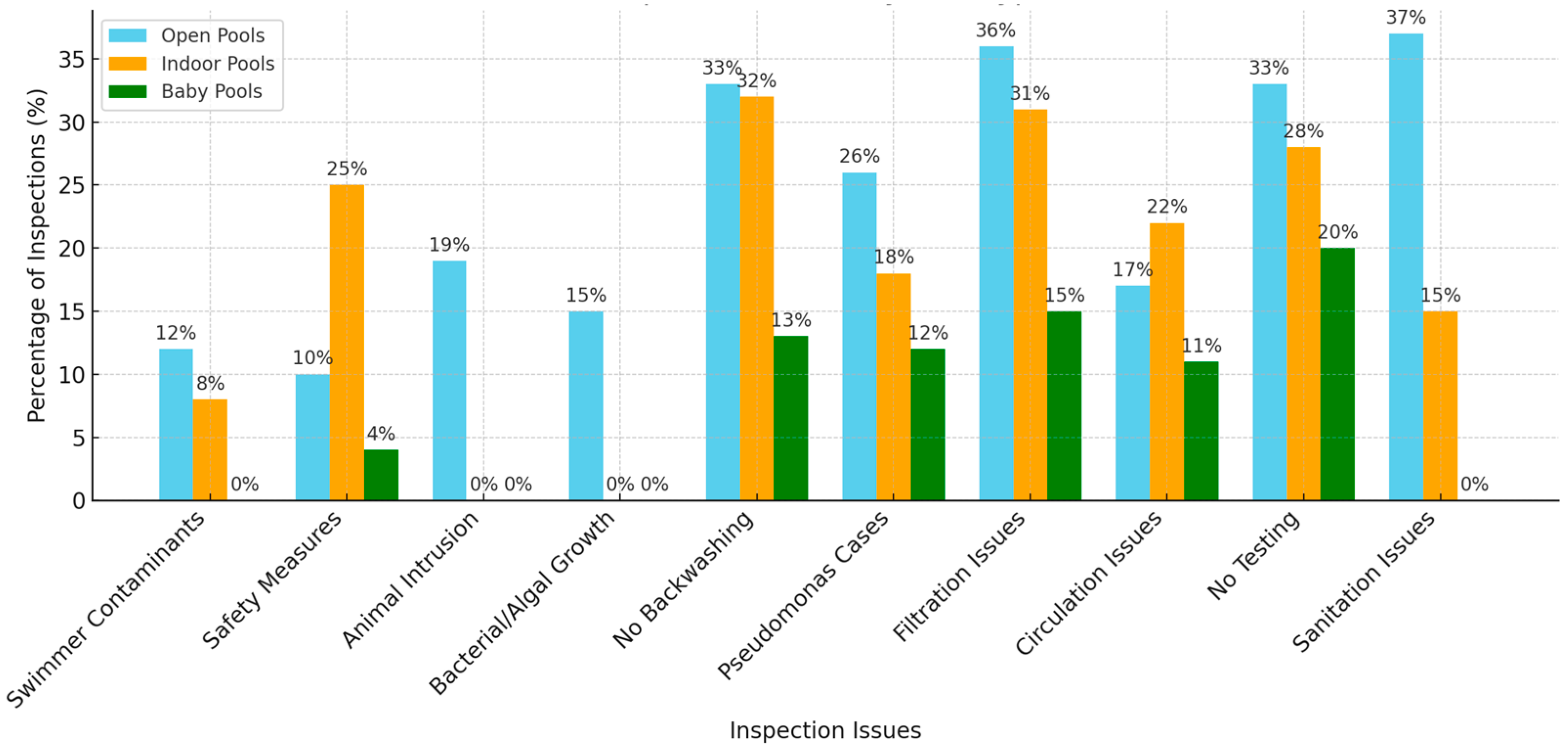
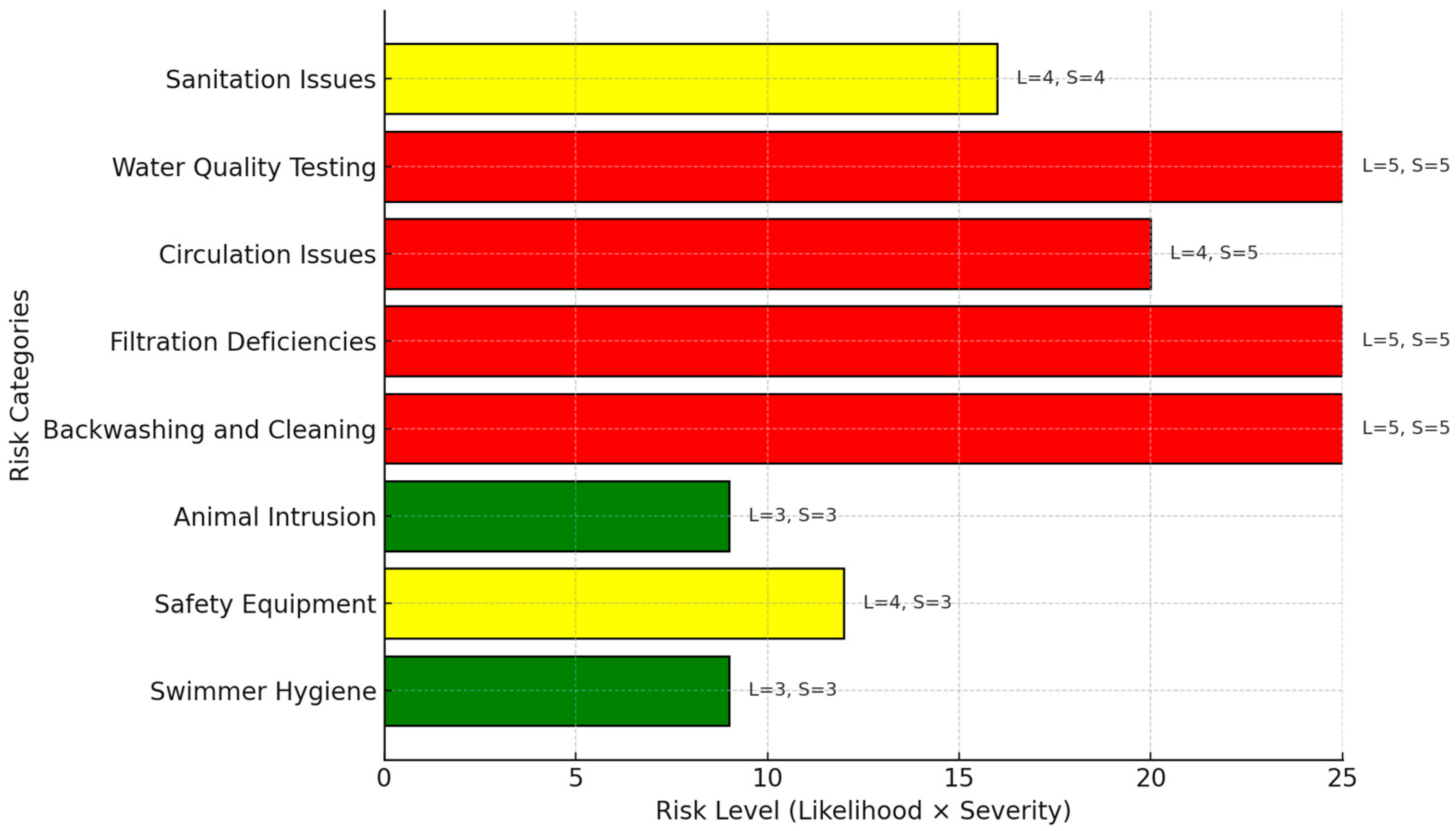
| Physicochemical Parameter | Requirement | Frequency Testing | Additional Notes |
|---|---|---|---|
| pH values | Must remain between 7.20 and 8.20 | At least twice daily (morning and afternoon) | Results to be recorded in a dedicated logbook. |
| Residual chlorine levels | Minimum: 0.4 mg/L Maximum: 0.7 mg/L | At least twice daily (morning and afternoon) | Measured using the orthotolidine method. |
| Alkalinity | Must be at least 50 mg/L | At least once daily (morning and afternoon) | Results to be recorded in a dedicated logbook. |
| Microbiological Parameter | Requirement | Frequency | Additional Notes |
| Microbiological quality | During operation, pool water must meet the following criteria: | At least monitoring once a week |
|
| Basic Operational | Requirement | Frequency | Additional Notes |
| Water renewal | During operation | Continuous |
|
| Disinfection systems | Must function during operational hours and beyond as necessary to maintain water quality. | Continuous during operational hours | Ensures water is clear and microbiologically safe. |
| Likelihood | Description |
|---|---|
| Very likely | Observed in more than 70% of inspections or measurements. |
| Likely | Observed in 30–70% of inspections or measurements. |
| Possible | Observed in less than 30% of inspections or measurements. |
| Rare | Not observed during inspections or measurements. |
| Severity | Description |
|---|---|
| Low (minor) | Low impact, easily manageable |
| Moderate | Moderate impact, requiring intervention |
| High (severe) | High impact, posing significant risk |
| Risk Level | Description |
|---|---|
| Critical | Requires immediate intervention due to severe harm potential and high likelihood of occurrence. |
| High | Significant risk requiring prompt corrective action. |
| Moderate | Monitor and address as needed. |
| Medium | Moderate risk requiring regular monitoring and improvement measures. |
| Low | Minor risk, limited potential for harm, and manageable through routine practices. |
| Variable | Open Athletic Pools | Indoor Pools | Baby Swimming Pools | |||
|---|---|---|---|---|---|---|
| No. of Samples | % | No. of Samples | % | No. of Samples | % | |
| Residual chlorine: <0.4 mg/L | 10 | 20.83 | 4 | 8.33 | 1 | 1.39 |
| Residual chlorine: 0.4–0.7 mg/L | 8 | 16.66 | 3 | 6.25 | 11 | 15.28 |
| Residual chlorine: 0.71–1.0 mg/L | 2 | 4.17 | 7 | 14.58 | 2 | 2.77 |
| Residual chlorine: 1.1–2.0 mg/L | 7 | 14.58 | 11 | 22.92 | 16 | 22.22 |
| Residual chlorine: 2.1–3.0 mg/L | 9 | 18.75 | 9 | 18.75 | 29 | 40.28 |
| Residual chlorine: >3.1 mg/L | 12 | 25 | 14 | 29.16 | 13 | 18.06 |
| Requirements | Hazard | Risk Level | Population at Risk | Likelihood | Severity | Proposed Mitigation Measures |
|---|---|---|---|---|---|---|
| Free Residual Chlorine (<0.4 mg/L) | Microbial contamination leading to health risks (e.g., infections from P. aeruginosa, Enterococci). | Critical | All users, especially children | Likely | High | Regular monitoring of free chlorine levels, ensure levels meet the legal range (0.4–0.7 mg/L), implement corrective actions to increase chlorine levels where necessary. |
| Free Residual Chlorine (>0.7 mg/L) | Over-chlorination causing irritation (eyes, skin, and respiratory) and formation of disinfection by-products (DBPs). | High | All users, vulnerable populations | Likely | High | Systematic reduction in chlorine concentrations to comply with legal limits; train pool managers on risks of over-chlorination and measures to mitigate exposure. |
| pH (>8.0 or <7.0) | Reduced disinfection efficacy, corrosive water causing infrastructure damage, and user irritation. | Critical | All users | Likely | High | Maintain pH within the optimal range (7.2–7.8), monitor daily, and use appropriate chemicals to adjust pH levels. |
| Combined Chlorine (>0.5 mg/L) | Chemical imbalance causing respiratory and skin irritations, indicating inadequate water management. | Moderate | All users | Possible | Moderate | Ensure combined chlorine concentrations remain below 0.5 mg/L, and optimize pool maintenance processes, including filtration and ventilation, especially in indoor settings. |
| Total Alkalinity (<80 mg/L) | pH instability causing corrosive water, discomfort, and infrastructure damage. | Medium | All users | Likely | Moderate | Adjust alkalinity levels using increasers to achieve 80–120 mg/L, and implement systematic monitoring to maintain balance. |
| Cyanuric Acid (>50 mg/L) | Reduced disinfection efficacy, water turbidity, and decreased visibility in outdoor pools. | Medium | Users of outdoor pools | Likely | Moderate | Limit cyanuric acid levels to 30–50 mg/L; avoid overuse of stabilizers; dilute water periodically to maintain appropriate levels. |
| Microbial Contamination | Infections caused by P. aeruginosa, Enterococci, total coliforms, and E. coli. | Critical | All users | Likely | High | Perform systematic microbial testing; comply with chlorine and pH standards, and improve filtration and circulation systems, especially for high-risk settings such as baby pools and outdoor pools. |
| Disinfection By-Products (DBPs) | Long-term carcinogenic and non-carcinogenic health effects from chemical exposure. | High | Indoor pool users, workers | Possible | High | Optimize chlorine dosing to minimize DBP formation, enhance ventilation, and educate staff on DBP risks and mitigation strategies. |
| UV Radiation Impact | Accelerated chlorine loss, reducing disinfection efficacy in outdoor pools. | Medium | Outdoor pool users | Possible | Moderate | Use cyanuric acid stabilizers effectively, monitor chlorine levels more frequently during peak sunlight hours, and educate pool managers on the impact of UV radiation. |
| User Hygiene | Contamination from users due to lack of pre-entry showering or overcrowding. | Moderate | All users | Likely | Moderate | Enforce pre-entry hygiene rules; regulate pool occupancy to avoid overcrowding; increase signage and awareness campaigns to encourage user compliance. |
| Chemical Handling Risks | Health hazards for workers from exposure to concentrated chemicals during water treatment. | Moderate | Pool workers | Rare | High | Train staff in proper chemical handling procedures. Staff Training on Chemical Handling (Offer certified training programs on the safe handling, dilution, and application of pool chemicals, including chlorine and pH regulators). Conduct routine refresher courses to ensure staff remain up to date with best practices and safety regulations, provide, and enforce the use of personal protective equipment (PPE). Enforcement mandates the use of gloves, safety goggles, and protective clothing when handling pool chemicals; ensure safe storage practices for pool chemicals. Ensure emergency eyewash stations and first aid kits are readily available near chemical storage and handling areas. Store chemicals in a well-ventilated, locked facility away from direct sunlight and moisture; keep incompatible chemicals (e.g., chlorine and acids) in separate, labeled storage units to prevent hazardous reactions.Implement a strict inventory management system to track chemical usage and expiration dates, ensuring proper disposal of outdated substances. |
| Category | Description of Risk | Likelihood | Severity | Risk Level | Control Measures |
|---|---|---|---|---|---|
| Sanitation | Inadequate cleaning of decks, surfaces, and unattended organic debris leading to microbial contamination | Likely | Moderate | High | Implement routine cleaning schedules, enforce strict sanitation protocols, and provide staff training. |
| Water quality testing | Absence of regular microbial and physicochemical testing, risking poor water quality and safety | Very Likely | Severe | Critical | Conduct daily testing of water quality, establish strict monitoring policies, and maintain logs for inspections. |
| Circulation issues | Stagnant water in “dead zones” leading to uneven disinfectant distribution and microbial growth | Likely | Severe | High | Optimize circulation systems, redesign areas prone to stagnation, and ensure consistent chemical distribution. |
| Filtration deficiencies | Delayed filter replacement, insufficient water circulation, and biofilm formation in pipes and filters | Very Likely | Severe | Critical | Regular maintenance of filters, timely replacements, and use of anti-biofilm treatments in pipes and filters. |
| Backwashing and cleaning | Absence of regular backwashing leading to equipment failure and water quality degradation | Very Likely | Severe | Critical | Develop a strict schedule for backwashing based on pool usage and water quality parameters, ensuring filters are cleaned at least once per week or when the pressure gauge indicates a 7–10 psi increase from the baseline level and cleaning of filtration systems to prevent degradation and ensure safety. Conduct deep cleaning of sand or DE filters every 3–6 months, depending on manufacturer recommendations and pool load, to prevent clogging and bacterial buildup. Inspect and replace cartridge filters as per manufacturer guidelines, typically every 6–12 months, or sooner if signs of wear, reduced flow rate, or persistent water cloudiness occur. Record all maintenance activities in a logbook, including backwashing dates, pressure readings, and any necessary repairs or replacements. Ensure staff training in proper filtration system maintenance, including recognizing early signs of filter degradation, such as decreased water clarity or slow circulation. |
| Animal intrusion | Birds, rodents, and insects accessing pool areas, increasing the risk of contamination | Possible | Minor | Moderate | Install pool covers, maintain perimeter fencing, and establish debris removal protocols. |
| Safety equipment | Missing life buoys, rescue poles, and other essential safety equipment | Possible | Moderate | Moderate | Ensure the availability of safety equipment at all times and conduct regular audits for compliance. |
| Swimmer hygiene | Contaminants from swimmers (sweat, urine, pathogens) due to lack of pre-swim showers and hygiene education | Possible | Minor | Moderate | Implement pre-swim shower policies, provide hygiene education to swimmers, Provide multilingual signage near shower facilities, explaining the importance of pre-swim hygiene for water quality, and enforce compliance with water quality testing. Use automated water monitoring systems for real-time tracking and immediate corrective action if parameters exceed limits. |
| Category: Sanitation Practices | |||||
|---|---|---|---|---|---|
| Type of Pool | Description of Risk | Likelihood | Severity | Risk Level | Control Measures |
| Open pools | Inadequate sanitation and cleaning protocols (27/38 inspections) leading to microbial contamination. | Likely | High | High | Regular cleaning schedules, training for staff, and clear sanitation protocols. |
| Indoor pools | Inadequate sanitation and cleaning protocols (11/38 inspections). | Likely | High | High | Comprehensive cleaning protocols and routine checks of cleaning equipment. |
| Baby pools | None observed. | Rare | Low | Low | Not applicable |
| Category: Water Quality Monitoring | |||||
| Type of Pool | Description of Risk | Likelihood | Severity | Risk Level | Control Measures |
| Open pools | Absence of regular microbial and physicochemical testing (24/58 inspections). | Likely | High | High | Daily water quality testing, automated monitoring systems, and compliance with water quality standards. |
| Indoor pools | Absence of regular microbial and physicochemical testing (20/58 inspections). | Likely | High | High | Mandated daily testing and employee training on water safety. |
| Baby pools | Absence of testing (14/58 inspections). | Likely | High | High | Frequent testing and smaller-scale monitoring. |
| Category: Circulation Issues | |||||
| Type of Pool | Description of Risk | Likelihood | Severity | Risk Level | Control Measures |
| Open pools | Stagnant water in “dead zones” and uneven disinfectant distribution (12/33 inspections). | Possible | High | Moderate | Optimized circulation design, regular maintenance of pumps, and strategic placement of inlets/outlets. |
| Indoor pools | Similar issues as open pools (13/33 inspections). | Possible | High | Moderate | Same as above. |
| Baby pools | Circulation issues (8/33 inspections). | Possible | Moderate | Moderate | Small-scale circulation systems and targeted maintenance. |
| Category: Filtration and Maintenance | |||||
| Type of Pool | Description of Risk | Likelihood | Severity | Risk Level | Control Measures |
| Open pools | Filtration deficiencies, delayed filter replacements (26/59 inspections). | Likely | High | High | Regular filter replacements, backwashing schedules (backwash sand and DE filters when the pressure gauge increases by 7–10 psi above the clean baseline or at least once per week during peak season; use a logbook to track backwashing frequency and ensure consistency in maintenance), and inspection of pipes for biofilms Conduct monthly inspections of pipes and plumbing using a borescope camera to detect biofilm buildup. Perform shock chlorination (10–20 mg/L for 4–6 h) every 3 months to eliminate microbial growth. Flush pipes with a high-pressure water jet or enzymatic cleaners to remove stubborn deposits |
| Indoor pools | Filtration deficiencies (22/59 inspections). | Likely | High | High | Same as above. |
| Baby pools | Filtration deficiencies (11/59 inspections). | Likely | High | High | Dedicated filtration systems for baby pools with frequent maintenance. Equip baby pools with independent filtration systems to prevent contamination from larger pools. Increase filtration turnover rates, ensuring the entire water volume is filtered at least every 30 min (compared to every 4–6 h for standard pools). Perform daily backwashing and disinfection of baby pool filters due to higher organic load (urine, fecal matter, lotions). Test water multiple times per day (at least every 2–3 h) for chlorine, pH, and bacterial contamination, adjusting treatment as needed. |
| Category: Safety Equipment | |||||
| Type of Pool | Description of Risk | Likelihood | Severity | Risk Level | Control Measures |
| Open pools | Lack of essential safety equipment (7/28 inspections). | Possible | High | Moderate | Mandatory availability of safety gear (install at least one life buoy every 25 m along the pool perimeter, securely attached to a rope of at least 15 m in length for easy retrieval). Place rescue poles (shepherd’s crooks) at both ends of the pool, ensuring they are long enough to reach the deepest area. Ensure that all safety equipment is highly visible, easily accessible, and mounted on designated stands near lifeguard stations or pool edges. Conduct weekly inspections and maintenance of safety gear to check for wear, damage, or missing equipment, with immediate replacements as needed. Train all lifeguards and pool staff on the proper use of safety gear and conduct emergency drills at least once per month to ensure readiness. |
| Indoor pools | Lack of safety equipment (18/28 inspections). | Possible | High | Moderate | Same as above. |
| Baby pools | Lack of safety equipment (1/28 inspections). | Rare | High | Low | Ensure proper safety provisions. (Install at least one life buoy with an attached rope within 5 m of the baby pool, ensuring easy access in case of emergencies. Provide non-slip surfaces around the baby pool area to prevent slipping and injuries. Place a rescue pole (shepherd’s crook) nearby, specifically designed for use in shallow water. Ensure the presence of a trained lifeguard or staff member monitoring the baby pool at all times when in use. Clearly mark water depth with visible signage and install child-proof barriers or fencing at least 1.2 m high to prevent unsupervised access. Conduct daily safety checks on all equipment, replacing damaged or missing items immediately. Educate parents and guardians with posted guidelines on proper supervision and pool safety rules. |
| Category: Animal and Bird Intrusion | |||||
| Type of Pool | Description of Risk | Likelihood | Severity | Risk Level | Control Measures |
| Open pools | Animal/bird intrusion due to lack of covers/fencing (14/14 inspections). | Likely | Moderate | Moderate | Install covers, fencing, and regular debris removal. |
| Indoor pools | None observed. | Rare | Low | Low | N/A |
| Baby pools | None observed. | Rare | Low | Low | N/A |
| Category: Swimmer-Related Contaminants | |||||
| Type of Pool | Description of Risk | Likelihood | Severity | Risk Level | Control Measures |
| Open pools | Contaminants such as sweat, urine, and feces due to insufficient hygiene measures (12/18 inspections). | Possible | High | Moderate | Enforce pre-swim showers, hygiene education, and clear rules. |
| Indoor pools | Similar issues (6/18 inspections). | Possible | High | Moderate | Same as above. |
| Baby pools | None observed. | Rare | Low | Low | N/A |
Disclaimer/Publisher’s Note: The statements, opinions and data contained in all publications are solely those of the individual author(s) and contributor(s) and not of MDPI and/or the editor(s). MDPI and/or the editor(s) disclaim responsibility for any injury to people or property resulting from any ideas, methods, instructions or products referred to in the content. |
© 2025 by the authors. Licensee MDPI, Basel, Switzerland. This article is an open access article distributed under the terms and conditions of the Creative Commons Attribution (CC BY) license (https://creativecommons.org/licenses/by/4.0/).
Share and Cite
Mplougoura, A.; Klona, K.; Mavridou, A.; Mandilara, G.D. An Assessment of Hazards and Associated Risks in Greek Swimming Pools. Water 2025, 17, 929. https://doi.org/10.3390/w17070929
Mplougoura A, Klona K, Mavridou A, Mandilara GD. An Assessment of Hazards and Associated Risks in Greek Swimming Pools. Water. 2025; 17(7):929. https://doi.org/10.3390/w17070929
Chicago/Turabian StyleMplougoura, Athina, Kiriaki Klona, Athena Mavridou, and Georgia D. Mandilara. 2025. "An Assessment of Hazards and Associated Risks in Greek Swimming Pools" Water 17, no. 7: 929. https://doi.org/10.3390/w17070929
APA StyleMplougoura, A., Klona, K., Mavridou, A., & Mandilara, G. D. (2025). An Assessment of Hazards and Associated Risks in Greek Swimming Pools. Water, 17(7), 929. https://doi.org/10.3390/w17070929






